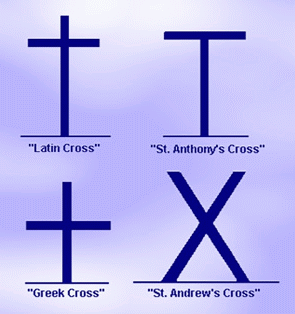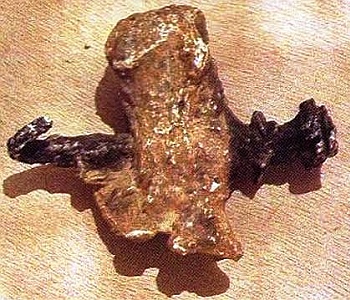font size | A A A


|
|
...crosses in use by the Roman Empire
|
Cross or Stake?
by haRold Smith
a citizen of the Commonwealth
(Ephesians 2:19)

|
The English word "cross" is used to translate the original Greek word,
stauros (
click on highlighted words to view content),
which actually means
"post or stake". The literal meaning of the original Greek word has led some to believe that Yeshua haMashiach was actually crucified on a stake, not a cross. This would mean that His arms would have been fastened directly overhead, rather than outward as traditionally believed. Although either could be right without in any way affecting the fact that Yeshua was crucified, a little study of history reveals some facts to be considered. To save the time and repetitive work that would result if done individually each time, the Romans often had the very heavy and cumbersome upright post/stake already in place, and it was the cross-section that is described as being carried to the site. Once there, Yeshua was nailed to the horizontal beam which was then lifted up and fastened to the upright stake.
There are 4 types of crosses that are known to have been used for crucifixions in the ancient world
(apart from that used by, for example, the Assyrians, who impaled the victim on an upright post - something that history tells us was not used by the Romans).
• The
"Latin Cross," or
crux immissa, is the traditional cross that is most often portrayed in illustrations and in "crucifixes." It was generally assumed that because a sign was nailed to the post above Jesus (John 19:19), there must have been a section of upright post above the horizontal beam.
• The
"St. Anthony's Cross," or
crux commissa, was actually the most commonly used cross used by the Romans for crucifixions. The upright post, which was notched at the top, was already in place. The executed man was tied or nailed to the cross-section, which was then simply lifted up and set into the notch at the top of the upright post.
• The
"Greek Cross" had equal-length vertical and horizontal sections.
• The
"Saint Andrew's Cross," or
crux decussata, was shaped like the letter X, with the two bottom legs set into the ground.

|
|
...the cross beam was hoisted on top of the pole/stake
|
The
crux commissa, shaped in the form of a capital T, was actually the commonly-used device used by the Romans for crucifixions. The upright post, which was notched at or into the top, was already in place. The executed man was tied and/or nailed (nailed through the wrists, not the hands which would not hold) to the cross-section (which was often carried to the place of crucifixion by the condemned man, as was done with Yeshua - the entire cross, which weighed 300-400 pounds, or more, was simply too heavy for anyone to carry or drag any distance); the cross beam, with the condemned man attached, was then simply lifted up (as Yeshua spoke of before it happened. i.e. "even so must the Son of man be lifted up" John 3:14) and set into the notch or joint at the top of the upright post. Thus, it can be stated accurately either way - cross or stake.
The Persians probably invented crucifixion, then it was copied by the Greeks and Romans - who perfected this horrifying way of killing a criminal. Originally the "cross" was simply a stake that impaled the head of someone already dead. From an engineering perspective, the T-shaped cross was quickly and easily assembled, and also the strongest, because the weight of the condemned man was drawing down directly into the notch or fitted joint, where it couldn't go anywhere, unlike the traditional idea of the crucifix that had the cross section fastened to the side of the post/stake, which could much more easily pull away. And, since the condemned man hung down below the level of the horizontal beam, there was still plenty of room for a sign to be nailed above his head, as was done with the Messiah; the "Yeshua of Nazareth, the King of the Jews" on the sign is shown written in Hebrew, Latin and Greek in
John 19:19-20.

|
|
...crucified ankle bone found at Giv'at ha-Mivtar
|
How do we know about crucifixion? Mostly from written sources like the gospels. But there is some archaeological evidence. Bodies of captives or executed criminals were usually dumped as rubbish, to be eaten by scavenging dogs. But in some cases, as with the death of Yeshua, the body was retrieved by grieving relatives and friends and given a decent burial. In 1968, the remains of one such man was discovered in a burial cave at
Giv'at ha-Mivtar, northeast of Jerusalem. This cave contained five ossuaries or bone boxes. In one of the ossuaries were the bones of a young man who had died in his mid-twenties, crucified at about the same time as Yeshua. A 4.5 inch (11.4 cm) nail was still lodged in the heel bone of the man. Apparently the people who buried him had been unable to pull it out. There was even a small wedge of wood remaining between the heel bone and the head of the nail, which had been put there by some Roman soldier to hold the nail and his foot firmly in place. According to the ossuary box inscription, his name was
Yehochanan, which in English is translated as "John". Both his leg bones had been smashed, something that was done to hasten the death of the crucified man. The gospels describing Yeshua's death emphasise that this did not happen to him, since he died quickly:
|
It was Preparation Day, and the Judeans did not want the bodies to remain on the stake on Shabbat, since it was an especially important Shabbat. So they asked Pilate to have the legs broken and the bodies removed. The soldiers came and broke the legs of the first man who had been put on a stake beside Yeshua, then the legs of the other one; but when they got to Yeshua and saw that he was already dead, they didn't break his legs. However, one of the soldiers stabbed his side with a spear and at once blood and water flowed out ...For these things happened in order to fulfill this passage of the Tanakh:
"Not one of his bones will be broken."
John 19:31-36
|
 ???Questions???
???Questions???
Please feel free to email me at harold@hethathasanear.com.
While not claiming to have all
the answers, it would be an honor to partake with you of what Spirit is uncovering.


